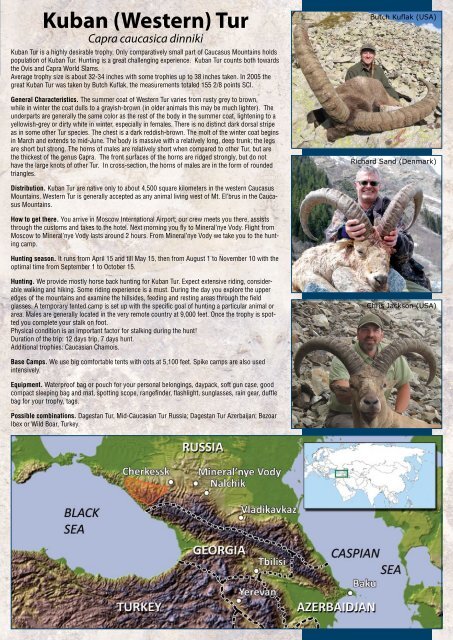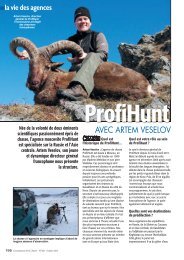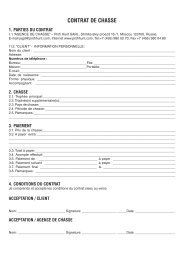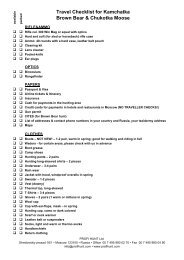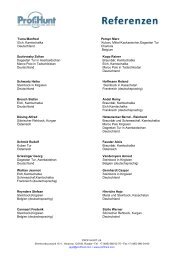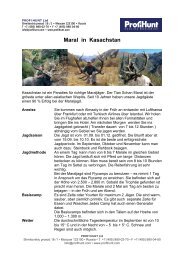You also want an ePaper? Increase the reach of your titles
YUMPU automatically turns print PDFs into web optimized ePapers that Google loves.
Kuban (Western) Tur<br />
Capra caucasica dinniki<br />
Kuban Tur is a highly desirable trophy. Only comparatively small part of Caucasus Mountains holds<br />
population of Kuban Tur. Hunting is a great challenging experience. Kuban Tur counts both towards<br />
the Ovis and Capra World Slams.<br />
Average trophy size is about 32-34 inches with some trophies up to 38 inches taken. In 2005 the<br />
great Kuban Tur was taken by Butch Kuflak, the measurements totaled 155 2/8 points SCI.<br />
General Characteristics. The summer coat of Western Tur varies from rusty grey to brown,<br />
while in winter the coat dulls to a grayish-brown (in older animals this may be much lighter). The<br />
underparts are generally the same color as the rest of the body in the summer coat, lightening to a<br />
yellowish-grey or dirty white in winter, especially in females. There is no distinct dark dorsal stripe<br />
as in some other Tur species. The chest is a dark reddish-brown. The molt of the winter coat begins<br />
in March and extends to mid-June. The body is massive with a relatively long, deep trunk; the legs<br />
are short but strong. The horns of males are relatively short when compared to other Tur, but are<br />
the thickest of the genus Capra. The front surfaces of the horns are ridged strongly, but do not<br />
have the large knots of other Tur. In cross-section, the horns of males are in the form of rounded<br />
triangles.<br />
Distribution. Kuban Tur are native only to about 4,500 square kilometers in the western Caucasus<br />
Mountains. Western Tur is generally accepted as any animal living west of Mt. El’brus in the Caucasus<br />
Mountains.<br />
How to get there. You arrive in Moscow International Airport; our crew meets you there, assists<br />
through the customs and takes to the hotel. Next morning you fly to Mineral’nye Vody. Flight from<br />
Moscow to Mineral’nye Vody lasts around 2 hours. From Mineral’nye Vody we take you to the hunting<br />
camp.<br />
Hunting season. It runs from April 15 and till May 15, then from August 1 to November 10 with the<br />
optimal time from September 1 to October 15.<br />
Hunting. We provide mostly horse back hunting for Kuban Tur. Expect extensive riding, considerable<br />
walking and hiking. Some riding experience is a must. During the day you explore the upper<br />
edges of the mountains and examine the hillsides, feeding and resting areas through the field<br />
glasses. A temporary tented camp is set up with the specific goal of hunting a particular animal or<br />
area. Males are generally located in the very remote country at 9,000 feet. Once the trophy is spotted<br />
you complete your stalk on foot.<br />
Physical condition is an important factor for stalking during the hunt!<br />
Duration of the trip: 12 days trip, 7 days hunt.<br />
Additional trophies: Caucasian Chamois.<br />
Base Camps. We use big comfortable tents with cots at 5,100 feet. Spike camps are also used<br />
intensively.<br />
Equipment. Waterproof bag or pouch for your personal belongings, daypack, soft gun case, good<br />
compact sleeping bag and mat, spotting scope, rangefinder, flashlight, sunglasses, rain gear, duffle<br />
bag for your trophy, tags.<br />
Possible combinations. Dagestan Tur, Mid-Caucasian Tur Russia; Dagestan Tur Azerbaijan; Bezoar<br />
Ibex or Wild Boar, Turkey.<br />
Butch Kuflak (USA)<br />
Richard Sand (Denmark)<br />
Chris Jackson (USA)


